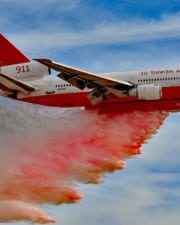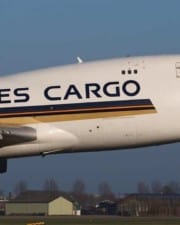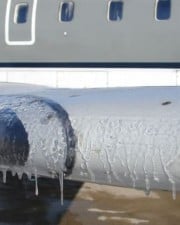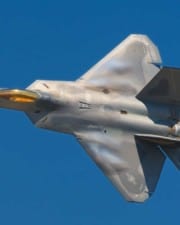Bush planes are specially designed airplanes made to fly in and out of very remote or rugged areas, including areas that may not even have landing strips or real airports. There are many different types of bush planes, and they can be a lot of fun to fly. Indeed, if you’re planning on piloting one of these planes any time in the future or if you’re merely curious about them, read on.
Table of Contents
Bush planes are unlike any other type of airplane because they are made to get into areas that may be a little outside of the norm, including forests, tundra, and glaciers, to name a few. If you’re interested in seeing the more remote parts of the world and you’re wondering how to do it, flying a bush plane might be your best bet.
What Is A Bush Plane?
A bush plane is one that is flown into remote locations, or ‘the bush’. Whilst today, the bush is typically associated with inhospitable areas of Australia and South Africa, the term has been used for many years in Canada and Alaska to describe locations inaccessible by the road or ferry network.
Bush flying was born over 100 years ago, in 1919 Northern Canada, after pilots returning from WW1 began to use flying boats to map forested areas and spot fires. Since, their uses have expanded to include rescue flights, transport of people and goods, airmail, safari and air tours.
Today bush planes are used in some of the world’s most extreme environments; in New Zealand’s mountains, Kenya’s deserts and even the Amazon rainforest.
To be fit for purpose, bush planes must have a short take-off roll and landing distance to help them get in and out of tight spaces. They are also designed to give ample ground clearance from environmental obstacles.
To achieve this, they usually have high-mounted wings placed on top of the fuselage, a feature which also helps to reduce damage during loading. The taildragger design is very common as it reduces drag and is more durable when landing on rough surfaces.
Often, bush airplanes come with equipment that includes skis, tundra tires, and floats. They were originally designed to get into areas such as the Canadian north and Alaska. They are now used to transport food and medicine into places that can only get these necessities by air; most importantly, they are perfect for pilots who are less traditional and a lot more adventuresome.
Bush planes have been known to land in areas so remote that there is no airstrip. Often, the area where they land is overgrown with vegetation and can make landing rather difficult. For the pilot who likes to go against the grain, flying these airplanes is a real adventure and each one has its own unique features and advantages.
1. Barrows Bearhawk
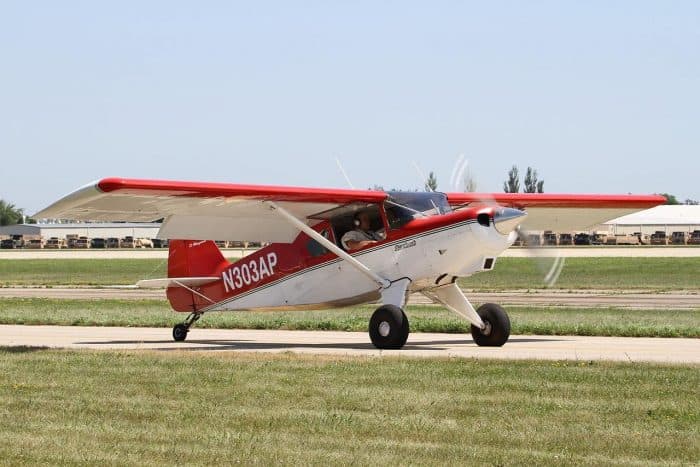
Also known as the Barrows 4-Place Bearhawk, this bush plane is provided as a kit and is perfect for the do-it-yourself aviation enthusiast. It has a four-seat enclosed cabin and a single engine in a tractor configuration. Its wings are made from aluminum and the fuselage is made out of welded steel tubing, which is then covered in doped aircraft fabric.
The manufacturers of the Bearhawk recommend using a standard engine that is 150 to 260 hp and takes roughly 1200 hours to put together. On the prototype of this airplane, a Lycoming O-360 170-hp engine was used as well as regular automotive fuel. There are many variants of this type of airplane. Its empty weight is roughly 1400 pounds. It holds up to three passengers and one crew member and it is roughly 24 feet in length.
2. Cessna 208 Caravan

This is a single-engine turboprop bush flyer that seats nine passengers and a single pilot. Developed in 1981, the Cessna Caravan has many variants that include one made specifically for Federal Express. Through its various design alterations, the plane now boasts a glass cockpit with a complete GPS system and a higher-powered engine, the P&WC PT6A-140, which is an 867 shaft horsepower engine.
The design of this airplane includes a fixed tricycle landing gear and either standard seats or a cargo compartment. Other variations include a combination of cargo and passengers, 1-1 seating, an underbelly cargo pod, and even a left-side cargo hatch that can be converted to a roll-up door. This type of plane has sometimes been converted to a skydiving plane.
3. de Havilland Canada DHC-6 Twin Otter

The de Havilland Canada DHC-6 Twin Otter is a 19-passenger STOL — short takeoff and landing — bush plane that has been used by skydiving teams, cargo and medical evacuation units, and U.S. military parachuting and flying teams. In other words, this is a very versatile plane that is very popular with both bush pilots and many civil and military organizations.
The DHC-6 Twin Otter accommodates one or two cockpit members, can be over 15 feet in length, and has a climb rate of 1600 feet per minute. Bush pilots love this plane for two main reasons: the power and reliability of the turboprop engine and the improved performance that comes with a twin-engine configuration.
4. Douglas DC-4

The Douglas DC-4 plane has four engines, is propeller-driven, and made by the Douglas Aircraft Company. There are military versions of this plane and they have been used worldwide for a variety of purposes. The plane is over 93 feet long, seats a crew of four, has an empty weight of 43,000 pounds, and can hold up to nearly 3600 U.S. gallons of gas.
Today, very few DC-4 planes are still in use but there are several of them being restored in areas such as Australia and Canada. The Douglas DC-4 is over 27 feet high and has a wing area of 1460 square feet. It also has constant-speed propellers that are a little more than 13 feet in diameter, and a maximum speed of 260 mph at 14,000 feet.
5. Gippsland (GippsAero) GA-10

The Gippsland GA-10 is a turboprop plane that has 10 seats and is manufactured in Victoria, Australia. It has a gross weight of 4,750 pounds and a height of 12 feet 9 inches as well as a fuel capacity of 153 U.S. gallons. It is a little over 33 feet long and has a wingspan of over 40 feet. It is therefore quite impressive for a bush plane.
This plane also has a 1000 foot/minute climb rate and a cruise speed of 167 mph. In 2018, while the newer versions were being tested, the GA-10 company announced that the first customer for the Airvan was Major Blue Air, an airline based out of Botswana.
6. Murphy Rebel

This airplane was designed by the manufacturers of the de Havilland DHC-2 Beaver and it is a taildragger monoplane that is sold in kit form by a Canadian company by the name of Murphy Aircraft. The company recommends certain engines for this plane including the Lycoming O-320, a 160 hp engine; the Lycoming O-235, a 116 hp engine; and the Rotax 912, an 80 hp engine.
Although the plane only holds two to three people, it is 21 feet long and has a gross weight of 1650 pounds. Its cruise speed is 120 mph and it can fly for roughly six hours at a time. The Rebel also has fixed conventional landing gear and a single engine in tractor configuration as well as a wingspan of 30 feet. The aircraft itself is made out of sheet aluminum and it was specifically designed to be a bush plane for personal use.
7. PAC P-750 XSTOL

The PAC P-750 airplane is a utility plane made in a monoplane design and containing a fixed tricycle undercarriage. The manufacturers combined the wings and engine of the PAC Cresco with a modified tail and a large fuselage as well as a 750 hp Pratt & Whitney Canada PT6 turboprop engine. It can accommodate either 17 parachutists or one pilot and up to nine passengers and it is over 36 feet in length.
There are currently plans underway to increase payload for this plane, including replacing aluminum flight-control surfaces with composite and installing lighter seating, which is planned for 2020. About 70% of these planes currently sold are to utility and passenger aircraft purchasers. The PAC P-750 is available in numerous configurations including agriculture, cargo, surveillance, skydiving, and aerial surveying.
8. Quest Kodiak
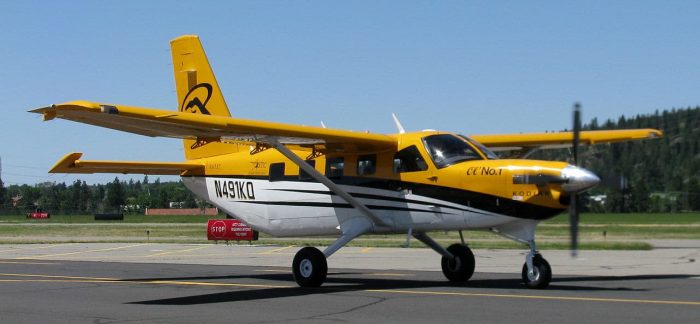
Built by Quest Aircraft, the Kodiak is an American utility plane that has a single turboprop engine and a fixed tricycle landing gear. Because it is deemed suitable for STOL operations from unimproved airfields, it makes for a very effective bush plane. It is also a relatively new plane, having made its maiden flight in the year 2004, and as over 250 of them have been delivered of 2018.
The Kodiak can accommodate up to nine passengers and one pilot and it is more than 34 feet in length. It has a height of more than 15 feet, a wing area of 240 square feet, and a cruising speed of 174 KTAS and 12,000 feet. It can fly for roughly 10 hours and has a maximum speed of 183 KTAS. Its maximum takeoff weight is 7255 pounds and its reversible propeller is a constant-speed feathering type of propeller.
9. Zenith STOL CH 701

This is a light, two-place aircraft that comes in a kit as many bush flyers do and it was designed in Canada. Having made its maiden flight in 1986, the CH 701 is currently manufactured in the United States and it can accommodate a crew of two people. The plane has an empty weight of 580 pounds and a fuel capacity of 20 U.S. gallons so it isn’t a particularly large airplane. However, it is an efficient plane and has a maximum speed of 85 mph at sea level.
The CH 701 can fly for nearly five hours and has a climb rate of 1000 feet per minute. It has been operated frequently by the Indian Air Force and it boasts several variants, including the CH 750, CH 701SP, CH 750 Cruzer, and the STOL CH 750 Super Duty, among others. It is a 20-foot-long plane that is eight feet high and has a 27-foot wingspan.
References ▾
Related Posts


